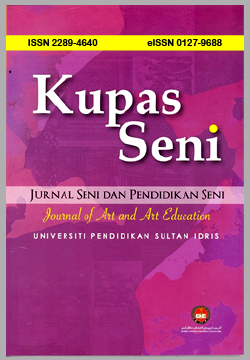Integration of Art in English Teaching Through Storybooks to Readers
DOI:
https://doi.org/10.37134/kupasseni.vol11.1.2.2023Keywords:
Integration of Art, English, Teaching, StorybooksAbstract
This abstract provides an overview of the integration of art in English teaching through storybooks to readers in an ESL classroom. It encompasses the definition of storybooks, their purpose in teaching English, the issues associated with their use, the implementation strategies for incorporating storybooks into English instruction, and the significance of storybooks for both teachers and readers. The integration of art in English teaching through storybooks offers a valuable approach to engage readers in ESL classrooms. While there may be challenges in using storybooks, implementing appropriate strategies can address these issues. By leveraging the power of storybooks, teachers can enhance language learning outcomes and create a positive and inspiring learning environment for their readers.
Downloads
References
Al-Jarf, R. (2015). Enhancing reading and speaking skills in EFL through multicultural children's short stories. In 7th International Conference, Building Cultural Bridges (ICBCB) titled: Integrating Languages, Linguistics, Literature, Translation, and Journalism into Education. Suleyman Demire lUniversity, Almaty, Kazakhstan. https://files.eric.ed.gov/fulltext/ED610158.pdf
Amanambu, O. V., Ekechukwu, L. E., Onuora, N. T., Ejimonye, C. O., Ikeazota, O. L., Oforka, T. O., & Ololo, K. O. (2021). Relevance of storybooks in promoting students' reading culture. Library Philosophy and Practice , 1-24,1A-1B. Retrieved from https://www.proquest.com/scholarly-journals/relevance-storybooks-promoting-students-reading/docview/2603241967/se-2
Beauchat, K. A., Blamey, K. L., & Walpole, S. (2009). Building preschool children's language and literacy one storybook at a time. The Reading Teacher, 63(1), 26-39. Building Preschool Children's Language and Literacy One Storybook at a Time
Dickinson, D. K., Griffith, J. A., Golinkoff, R. M., & Hirsh-Pasek, K. (2012). How reading books fosters language development around the world. Child development research, 2012. https://downloads.hindawi.com/archive/2012/602807.pdf
Doyle, B. G., & Bramwell, W. (2006). Promoting emergent literacy and social–emotional learning through dialogic reading. The Reading Teacher, 59(6), 554-564. https://readitonceagain.com/wp-content/uploads/2017/08/Promoting-early-literacy-and-social-emotional.pdf
Fang, Z. (1996). Illustrations, text, and the child reader: what are pictures in children's storybooks for? Reading Horizons: A Journal of Literacy and Language Arts, 37(2), 3. Illustrations, Text, and the Child Reader: What are Pictures in Children's Storybooks for?
Gonen, M., & Guler, T. (2011). The environment and its place in children's picture story books. Procedia-Social and Behavioral Sciences, 15, 3633-3639. The Environment and Its Place in Children's Picture Story Books
Justice, L. M., Meier, J., & Walpole, S. (2005). Learning new words from storybooks. https://web.archive.org/web/20170808233642id_/http://ici-bostonready-pd-2009-2010.wikispaces.umb.edu/file/view/Learning%20New%20Words%20From%20Storybooks.pdf
Liu, Y. (2021). Integrating Various Resources in Supporting the Learning of English Learners. KOTESOL Proceedings 2021, 231. https://koreatesol.org/sites/default/files/pdf_publications/KOTESOL.Proceedings.2021.pdf#page=241
Mart, C. T. (2012). Encouraging Young Learners to Learn English through Stories. English Language Teaching, 5(5), 101-106. https://files.eric.ed.gov/fulltext/EJ1079458.pdf
Moedt, K., & Holmes, R. M. (2020). The effects of purposeful play after shared storybook readings on kindergarten children's reading comprehension, creativity, and language skills and abilities. Early Child Development and Care, 190(6), 839-854. https://www.tandfonline.com/doi/full/10.1080/03004430.2018.1496914?casa_token=Ny2jLOhL80YAAAAA:jdqHORayKRFiSZvOInV-804kCA_korUevKPbgceb4YuLVkPNwJ5vkwbxFdQzW8V8DP-XcJtAA3ULdw
Mulei, H. N., Kebaya, C., & Ndivo, L. (2023). Improving learners’ literacy competencies in early years education through children’s storybooks. Journal of Education, Curriculum and Teaching Studies, 4(1). https://royalliteglobal.com/ects/article/download/16-28/556
Putri, M. A., Harto, S., & Moecharam, N. Y. (2017). Promoting character education in EFL classroom: Using children’s literature as a teaching material. Journal of English and Education, 5(2), 163-169. https://core.ac.uk/download/pdf/295400847.pdf
Sanacore, J. (2006). Nurturing lifetime readers. Childhood Education, 83(1), 33-37. https://www.tandfonline.com/doi/pdf/10.1080/00094056.2006.10522874?casa_token=SsPhgdPQGC4AAAAA:6JKMX_mdwDXdxK_P4zNQYvYp8o_FVwFkQ-IZE46iR68sdsBEUCZtchlK_mp72grXutBTe2utRWeIaQ
Spencer, E. J., Goldstein, H., & Kaminski, R. (2012). Teaching vocabulary in storybooks: Embedding explicit vocabulary instruction for young children. Young Exceptional Children, 15(1), 18-32. (PDF) Teaching Vocabulary in Storybooks: Embedding Explicit Vocabulary Instruction for Young Children
Downloads
Published
How to Cite
Issue
Section
License
Copyright (c) 2023 Jewel Sanie Douglas

This work is licensed under a Creative Commons Attribution-NonCommercial-ShareAlike 4.0 International License.





